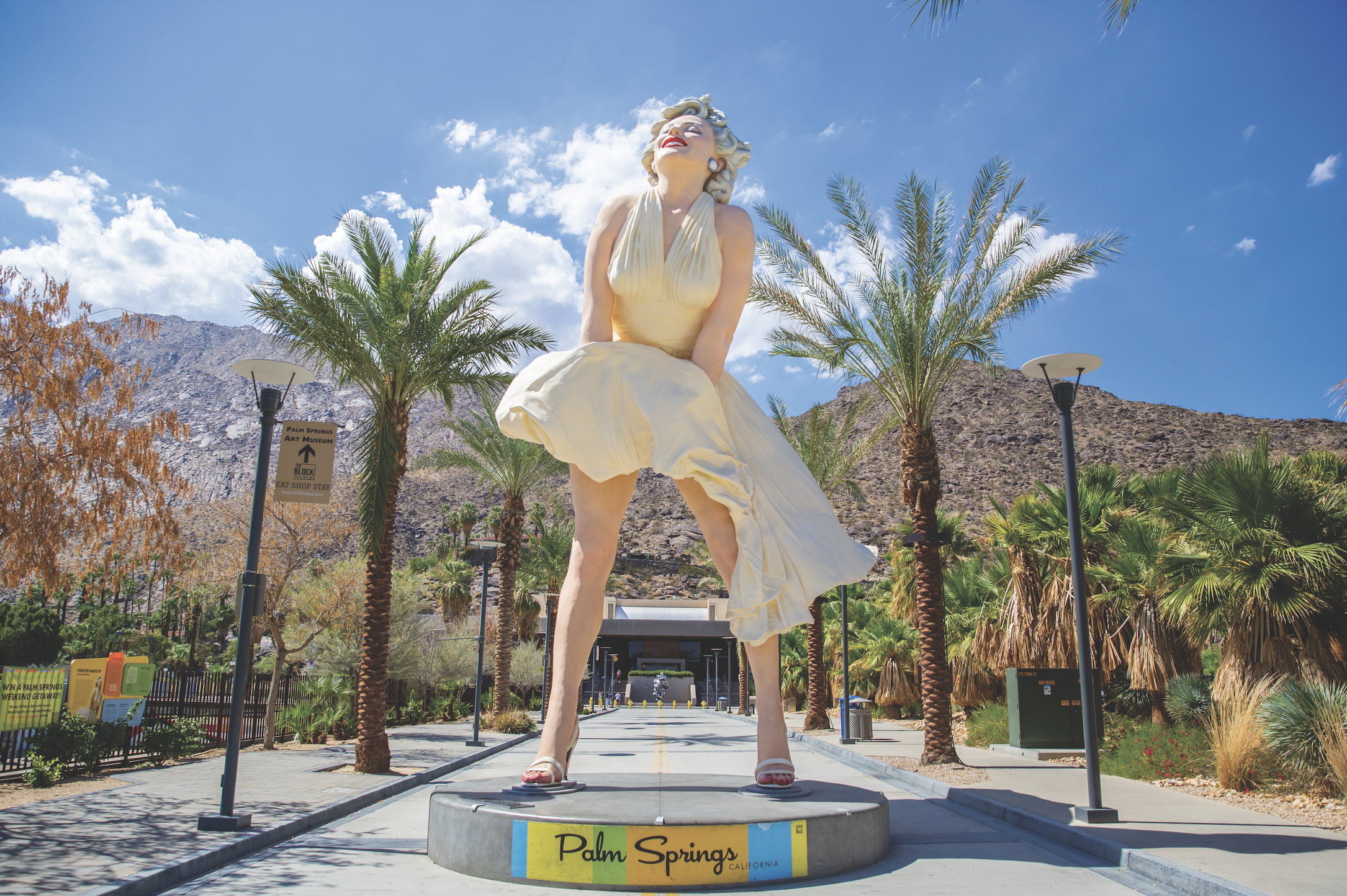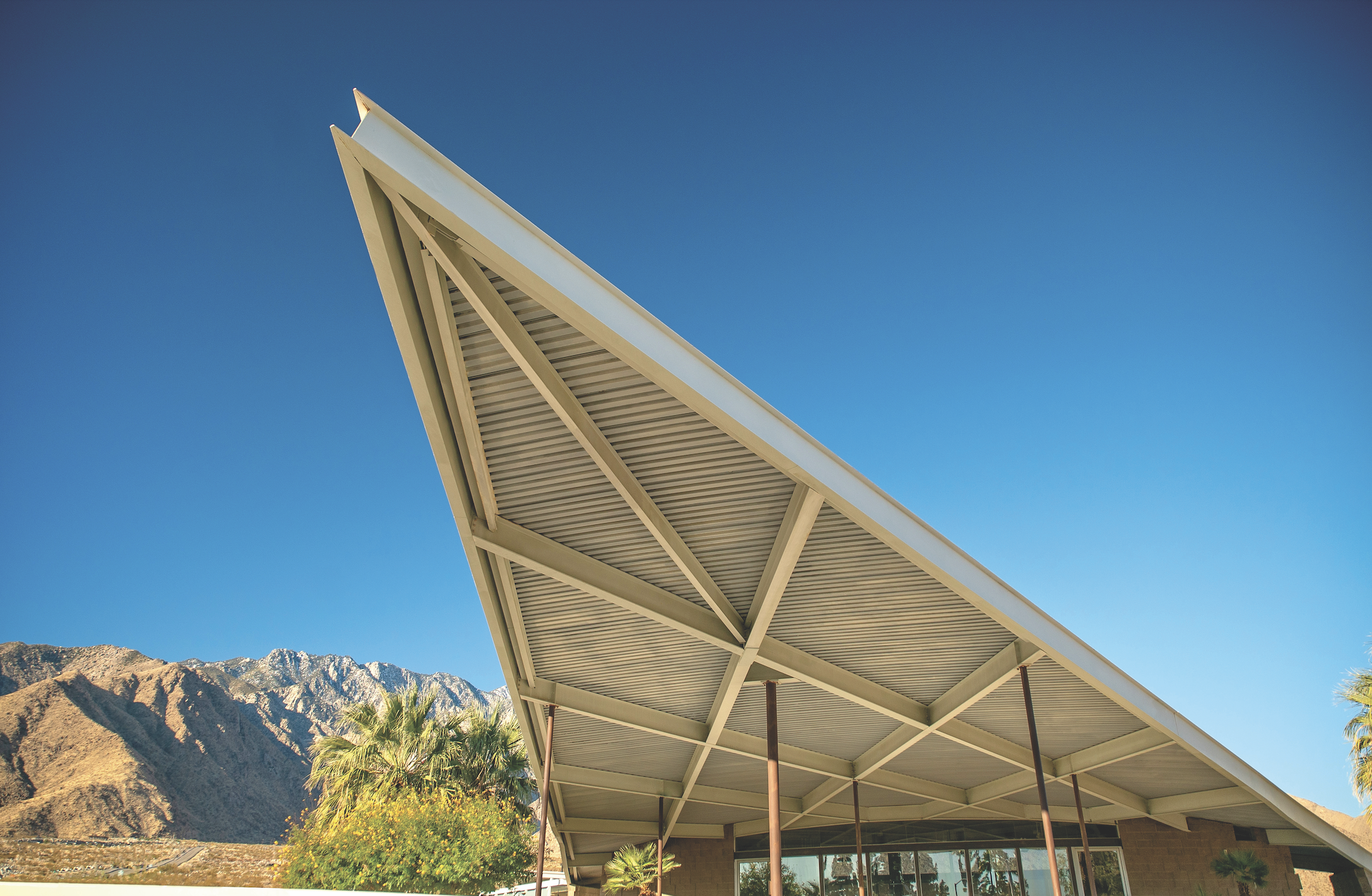Towards the end of his long life, Palm Springs architect Donald Wexler was invited to spend time at one of his finest creations: the former home of the 1940s and ’50s singer and TV icon Dinah Shore, which Wexler designed in 1964. He sat for hours in the property’s deep sunken lounge studying his masterpiece, created in the unique Midcentury style he helped pioneer — Desert Modernism.
Leonardo DiCaprio owns the house now (he bought it in 2014 for $US5.2 million [$AU8 million]), but when Shore was in residence, her parties — just like her pal Frank Sinatra’s — were Palm Springs’s most anticipated. Poolside soirees attended by Hollywood’s elite in 1960s and ’70s Palm Springs are now immortalised on walls around the world thanks to the photographer Slim Aarons’s iconic prints.
The home has some 700 square metres of living space, including six bedrooms and seven and a half bathrooms, each decorated a different colour (forest green was Shore’s favourite). There are deep soaking tubs and a Finnish sauna, a grand piano and a huge stone fireplace. As well as half a hectare of lawn, there’s a pool and a casita for guests beside a tennis court that has an extra gate, added so Shore’s neighbour Kirk Douglas didn’t have to walk the long way around to visit. It may be DiCaprio’s holiday home, but anyone with the means to rent it can do so, at $US3,750 ($AU5,750) per night.
Located at 432 Hermosa Drive, a few hundred metres off Palm Springs’s main drag, the Dinah Shore Palm Springs Estate is part of the Old Las Palmas neighbourhood, around the corner from Elvis and Priscilla Presley’s glass-dome honeymoon home. The house that Marilyn Monroe is rumoured to have rented is 200 metres away. At the end of the street, Elizabeth Taylor’s former place — a low-slung structure on a pretty 2,300-square-metre block colloquially known as “Casa Elizabeth” — just sold for $US3.5 million ($AU5.4 million).
As I ride through Old Las Palmas, I’m surrounded by low green hedges and boulevards of tall fan palm trees and endless rows of flowering pink and purple bougainvillea under blue skies. Dean Martin’s home, on my left, is swiftly falling into disrepair, the only one like it on this otherwise manicured street. Howard Hughes’s house is close by, and Liberace’s, too — he often waved to fans through his bedroom window as they lined the street outside during his last days, in 1987. All these homes — all this history, like a living museum — are all so, so close to the street. Beverly Hills, Bel Air and Malibu hide their stars within mega-estates behind patrolled gates, but in Palm Springs, anyone can walk in the footsteps of Hollywood’s greatest artists.

The appeal doesn’t just lie in the accessibility to the homes of the icons of Hollywood’s golden age — anyone with the means can live as they did. For $US3,300 ($AU5,060) a night, one can rent out Frank Sinatra’s Twin Palms home, completed in 1947, with its piano-shaped pool and the two palm trees after which the property was named. Apparently, Sinatra used to raise a Jack Daniel’s flag between the trees to let his neighbours know drinks were on.
But visitors to Palm Springs don’t need to go to such extravagant lengths to experience the town’s golden history. I’m staying at the late-1940s-era Villa Royale, just off the main road, tucked away behind walls of green vegetation. Like a lot of Palm Springs’s overnight options, it’s more time capsule than accommodation. It’s said that Irving Shulman came up with the idea for the screenplay of “Rebel Without a Cause” while lounging by the pool outside my room, looking over palm trees to the snow-covered San Jacinto Mountains behind (I can’t think of anywhere else on earth where palms and snow coexist quite like this). Tiny hummingbirds with amethyst helmets and dusky green tail feathers hover among the citrus trees that line the path to my room. Dinner is served at the intimate bar and eatery Del Rey, a labyrinth of oak and marble set deep inside stucco walls. Afterwards, guests can retire to chairs around a firepit on the cobblestones, beneath the other stars of this town. There’s a black and white photo of the Beatles on the wall in the reception area; I don’t ask if they stayed here, preferring it to remain a mystery. Because in this town, who knows?


In the heart of Palm Springs, guests still dress to the nines at Melvyn’s Restaurant, a classic American steakhouse inside the 100-year-old hotel Ingleside Estate. There are white tablecloths and waiters in bow ties, and nightly jazz around the grand piano in the Casablanca Lounge. It was Sinatra’s favourite restaurant in town for decades; diners would stop talking when he showed up to eat. His table is the one in the corner, table 13. His order was steak Diane — he’d have it flambéed by his table.
Even the hotspots for the stars of today hark back to this golden age. The resort and hotel the Parker Palm Springs, which has attracted the likes of Angelina Jolie and Robert Downey Jr, was originally the estate of the Western movie star Gene Autry, also known as the Singing Cowboy. The Parker’s restaurant is so discreet I can barely find the place: there’s no signage except a neon “open” sign out the front. Downstairs at Mister Parker’s there’s a “jacket required” dress code for men, and soft velvet seating with lighting so dim I need the torch on my phone to read the menu. Leonardo DiCaprio occasionally rents out the restaurant on his visits.
Hollywood came to Palm Springs in the 1930s when the heads of the film industry passed a directive that talent had to stay within a two-hour drive of Hollywood while working on productions. But Palm Springs was a haven for artists long before it was a town of movie stars. Drawn by the stark desert landscape and the rich yellow light in a place where the sun shines 350 days a year, some of America’s greatest artists came here to live — painters such as Maynard Dixon and Conrad Buff. Most were unknown when they arrived; now, Dixon’s work sells for millions.
Art is all over Palm Springs if you take the time to look for it. There are murals and sculptures across Greater Palm Springs (the ArtsGPS app shows all the sites, exhibitions and art-related events) and there are even arts districts, like the Backstreet Art District on the drive out to Cathedral City, where studios of contemporary painters, sculptors and lithographers still carry the flame.
If it wasn’t for the Hollywood takeover, bus tours might be going to the homes and studios of Palm Springs’s best artists instead of the film stars’. There is an art trail of sorts: the Smoketree Art Trail includes the living and working spaces of some of the 20th century’s best-known artists. Many buildings have been torn down, and I have to look hard for those that still stand. My favourite is Korakia Pensione, three blocks west from Palm Springs’s downtown area. Originally called Dar Marroc, it was modelled on a Moorish castle. Scottish artist Gordon Coutts built it in the 1920s for the property’s unimpeded views of the snowcapped mountains above. Among the guests who visited — some to paint with Coutts — were Errol Flynn, Rudolph Valentino and Winston Churchill. The home has since been turned into a Mediterranean-style resort surrounded by half a hectare of citrus and olive trees and date palms. It’s still a popular gathering place for artists. There’s a studio on the upper level with an unobstructed view of the mountains that Coutts immortalised on canvas.
Even former US president Dwight Eisenhower came to Palm Springs to create art. Inspired by Churchill’s passion for painting, Eisenhower learned techniques from the famed local artist Paul Grimm, in a studio a short walk from one of the first hotels in town, the Desert Inn.


Despite Palm Springs’s storied history as a gathering place for the powerful and famous, the city’s architecture is the real star here. The iconic buildings are still standing, perfectly preserved in this high, dry desert air. Desert Modernism may live on forever, emulated as it is all over the world. There’s not one unsightly street in the entire place — Walt Disney’s house looks no different from his neighbours’ in this most egalitarian of Californian high societies — and the artistry begins the moment you arrive.
Donald Wexler designed the Palm Springs Airport in 1965 so that visitors arriving from wintry places could marvel immediately at the beauty of the desert through nearly 10-metre-high windows framing the San Jacinto Mountains. Palm Springs has one of the highest concentrations of preserved Midcentury modern architecture anywhere in the world. A cross-town drive here is a tourist attraction in itself: every hedge has been trimmed immaculately and flowers bloom even in the depths of winter.
Travel by car proves too fast to pick up the subtleties in the designs around me. Some days I walk the streets for hours. For 11 days each February during Modernism Week (and four days in October), visitors can go beyond the streets and into hundreds of homes.
Young architects with fresh ideas arrived here in the years after WWII — people like E Stewart Williams, who was commissioned by Sinatra to build a Georgian-style mansion to flaunt his wealth. He convinced the star to instead allow him to experiment with minimal lines, long low rooflines and floor-to-ceiling windows, bringing the outside of Palm Springs inside. Williams, Wexler, John Lautner and company created a whole new world in the desert.
These creations, the architects who conceived them and the other luminaries of canvas and screen who lived out here in the high desert stay alive through careful preservation. Palm Springs is not Beverly Hills. The point of being here is not to ogle, it’s to imitate: to follow in the footsteps of those who helped create one of the greatest little desert communities on earth.




 A house typical of the style known as Desert Modernism, which makes Palm Springs, California, a magnet for architecture fans. Photograph courtesy of Visit Greater Palm Springs.
A house typical of the style known as Desert Modernism, which makes Palm Springs, California, a magnet for architecture fans. Photograph courtesy of Visit Greater Palm Springs.